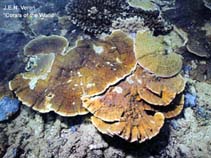Montipora friabilis Bernard, 1897
Warning: DOMDocument::load(): SSL operation failed with code 1. OpenSSL Error messages: error:140770FC:SSL routines:SSL23_GET_SERVER_HELLO:unknown protocol in C:\Apache24\htdocs\includes\SpeciesSummary.lib.php on line 1236
Warning: DOMDocument::load(): Failed to enable crypto in C:\Apache24\htdocs\includes\SpeciesSummary.lib.php on line 1236
Warning: DOMDocument::load(https://sealifebase.nrm.se/webservice/AquaMaps/getAMap.php?genus=Montipora&species=friabilis): failed to open stream: operation failed in C:\Apache24\htdocs\includes\SpeciesSummary.lib.php on line 1236
Warning: DOMDocument::load(): I/O warning : failed to load external entity "https://sealifebase.nrm.se/webservice/AquaMaps/getAMap.php?genus=Montipora&species=friabilis" in C:\Apache24\htdocs\includes\SpeciesSummary.lib.php on line 1236
Classification / Names Common names | Synonyms | CoL | ITIS | WoRMS
| Scleractinia | Acroporidae
Environment: milieu / climate zone / depth range / distribution range Ecologia
Associadas(os) a recifes. Tropical; 36°N - 27°S, 40°E - 154°E (Ref. 846)
Distribuição Países | Áreas FAO | Ecossistemas | Ocorrências | Introduções
Indo-West Pacific.
Length at first maturity / Tamanho / Peso / Idade
Maturity: Lm ? range ? - ? cm
Descrição suscinta Morfologia
Colonies are composed of thin delicate unifacial laminae forming flat or slightly upright whorls or irregular contortions. Corallites are immersed, but clearly visible. Coenosteum: coarse. No papillae. Surfaces of fronds: finely rough appearance. Polyps may be extended during the day. Pale brown or mauve.
Shallow turbid reef environments and lagoons (Ref. 846).
Life cycle and mating behavior Maturidade | Reprodução | Desova | Ovos | Fecundidade | Larvas
Members of the class Anthozoa are either gonochoric or hermaphroditic. Mature gametes are shed into the coelenteron and spawned through the mouth. Life cycle: The zygote develops into a planktonic planula larva. Metamorphosis begins with early morphogenesis of tentacles, septa and pharynx before larval settlement on the aboral end.
Referência principal
Referências | Coordenador | Colaboradores
Veron, J.E.N. 2000. (Ref. 846)
Status na Lista Vermelha da IUCN (Ref. 130435)
Vulnerável, ver Livro Vermelho da IUCN (VU) (A4ce); Date assessed: 01 January 2008
Status no CITES (Ref. 108899)
Appendix II: International trade monitored
CMS (Ref. 116361)
Not Evaluated
Perigo para os humanos
Uso pelos humanos
| FishSource |
Ferramentas
Mais informação
Fontes da internet
BHL | BOLD Systems | CISTI | DiscoverLife | FAO(Publication : search) | Fishipedia | GenBank (genoma, nucleotídeo) | GloBI | Gomexsi | Google Books | Google Scholar | Google | PubMed | Hexacorallians of the World | Árvore da vida | Wikipedia (Ir para, procura) | Registro zoológico
Estimates based on models
Preferred temperature
(Ref. 115969): 27.9 - 29.2, mean 28.7 (based on 344 cells).
Categoria de preço
(Ref. 80766):
Unknown.



